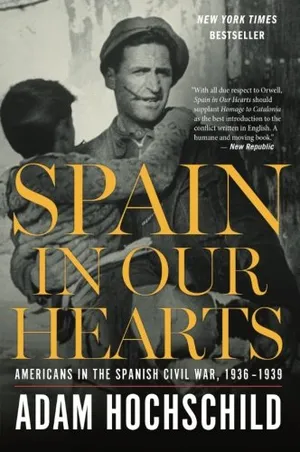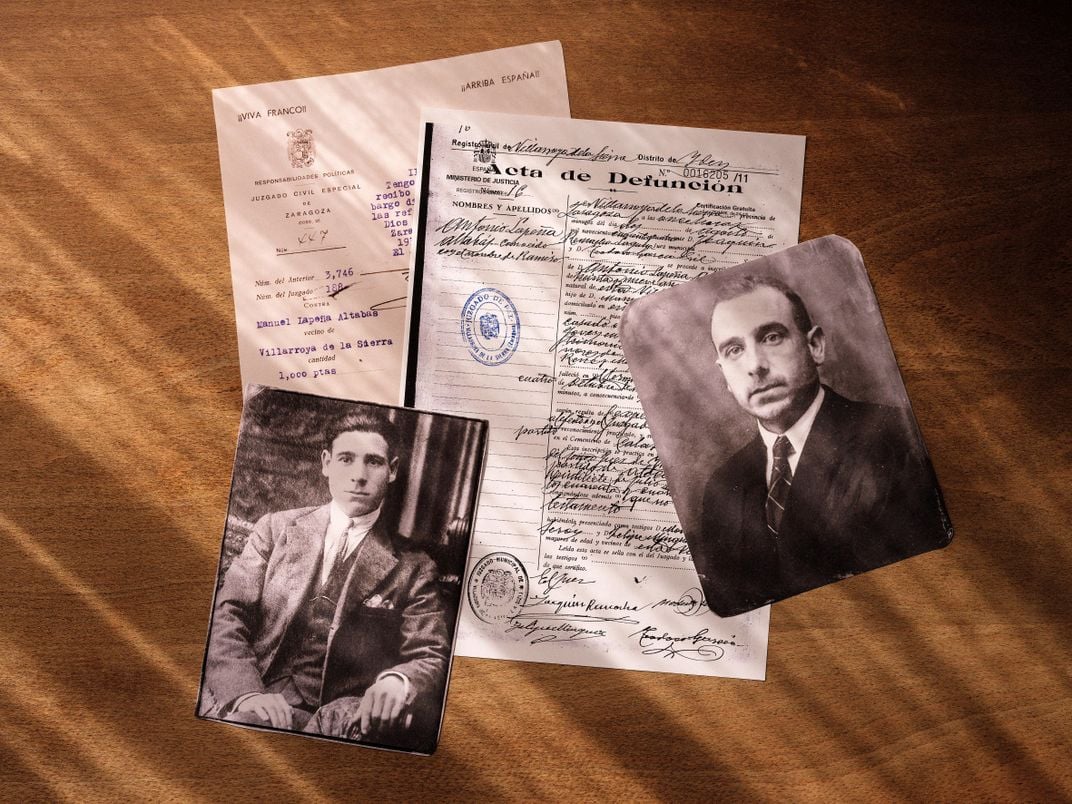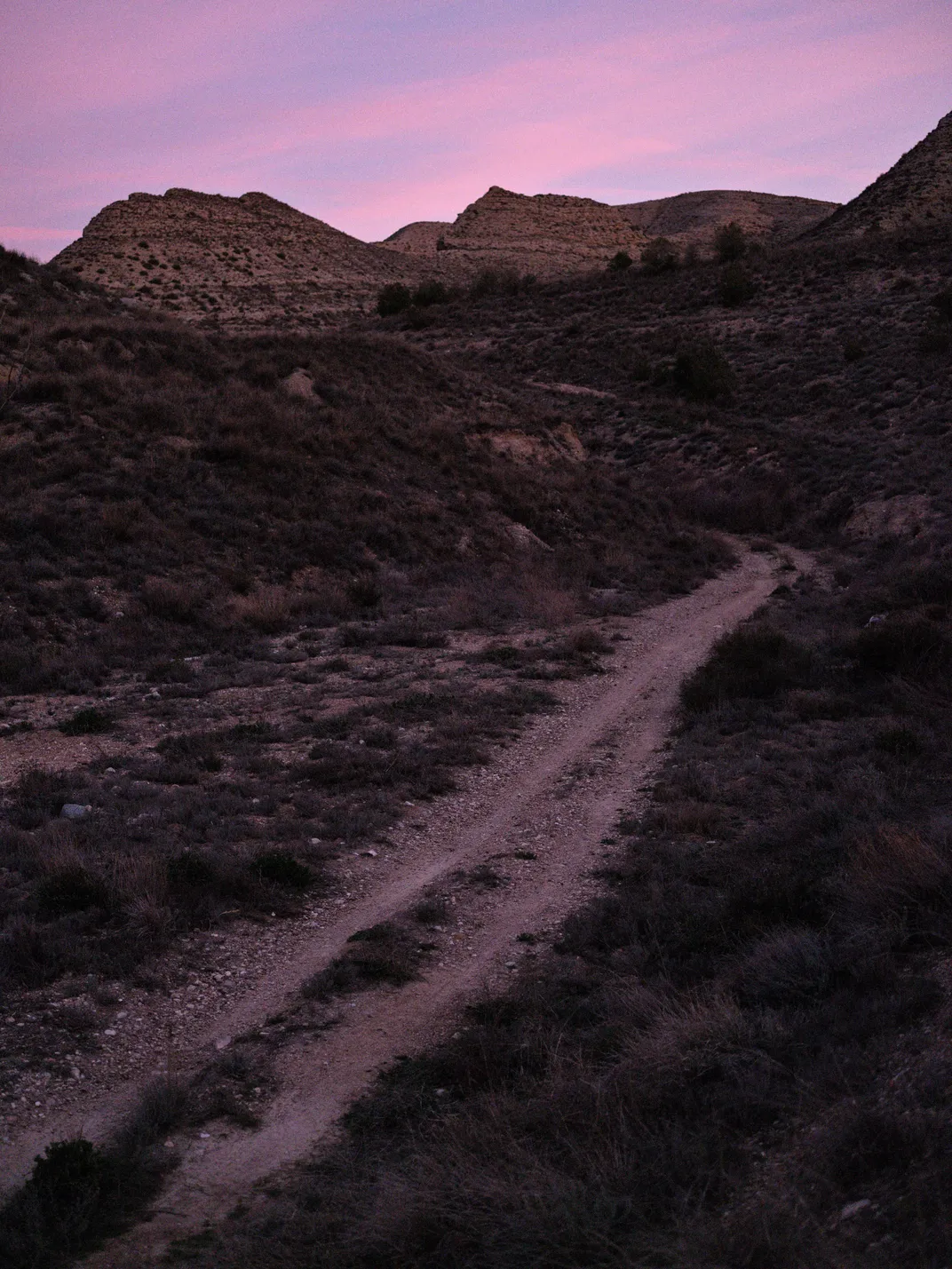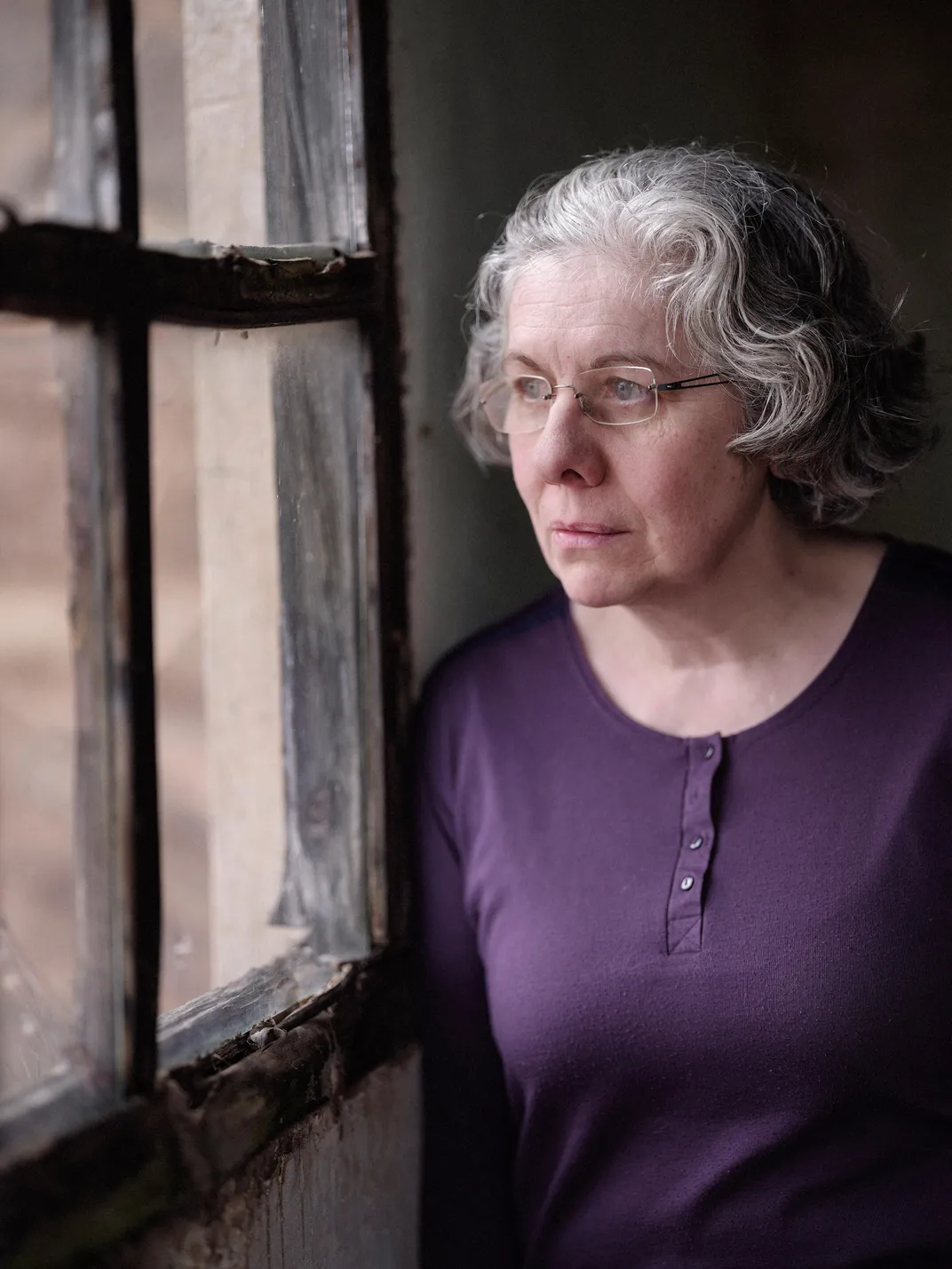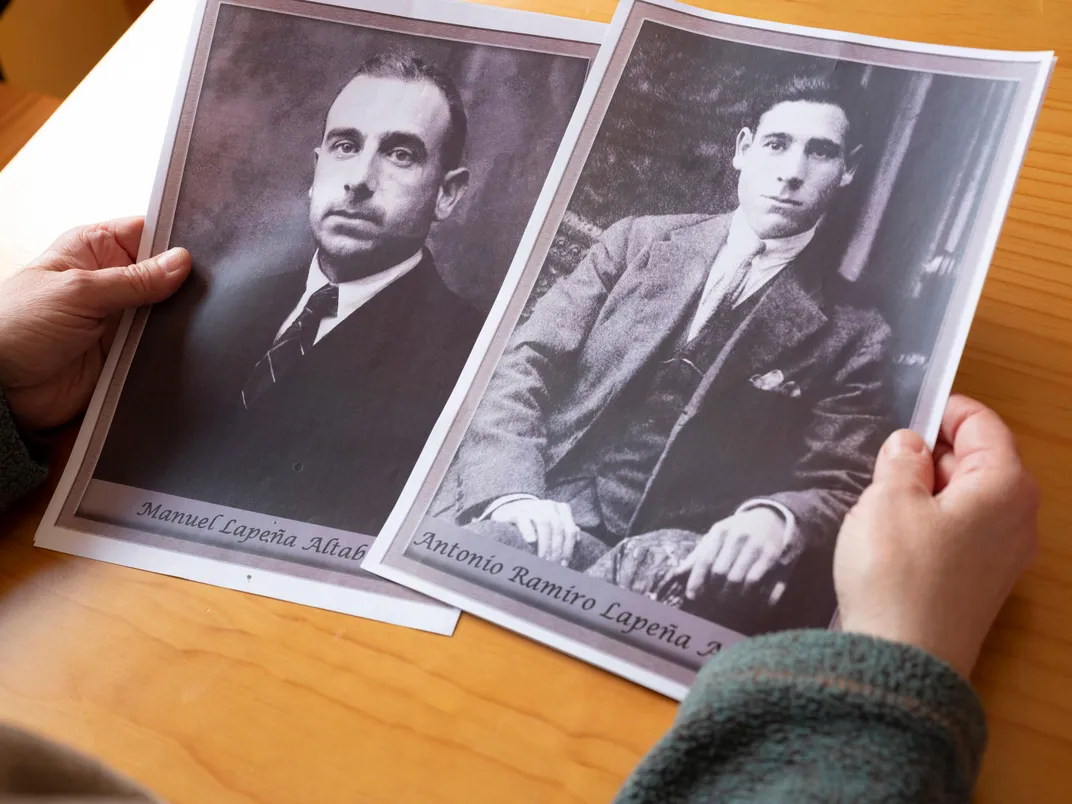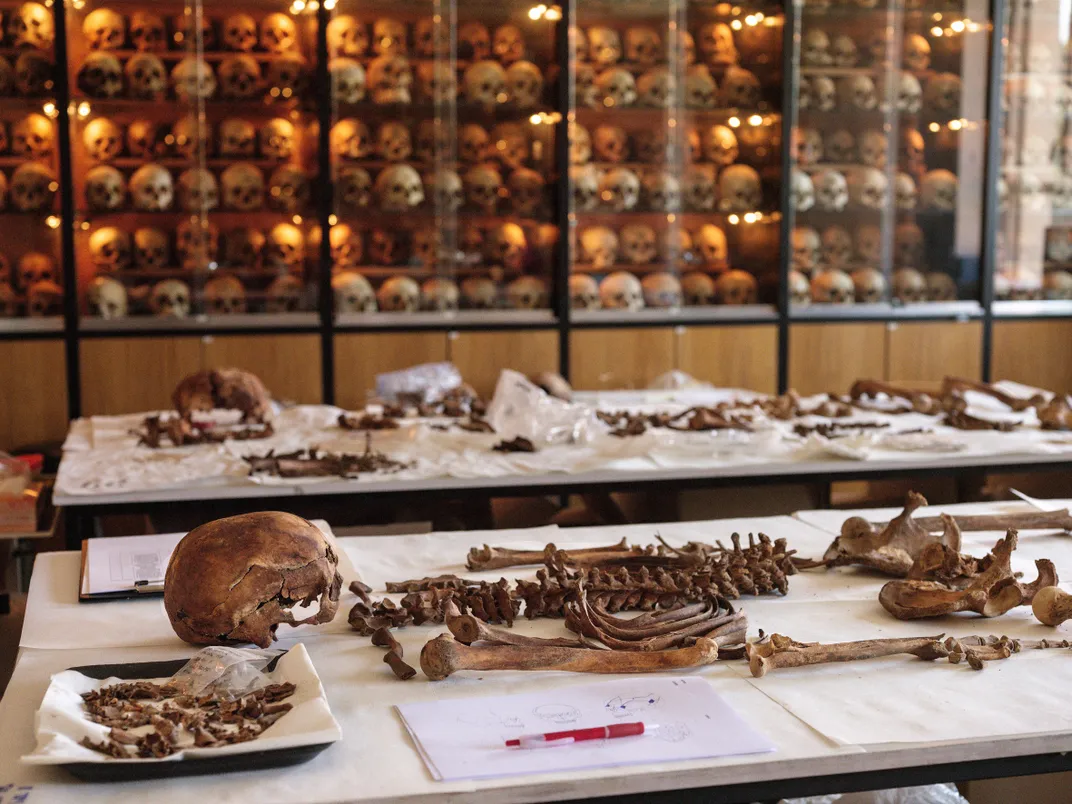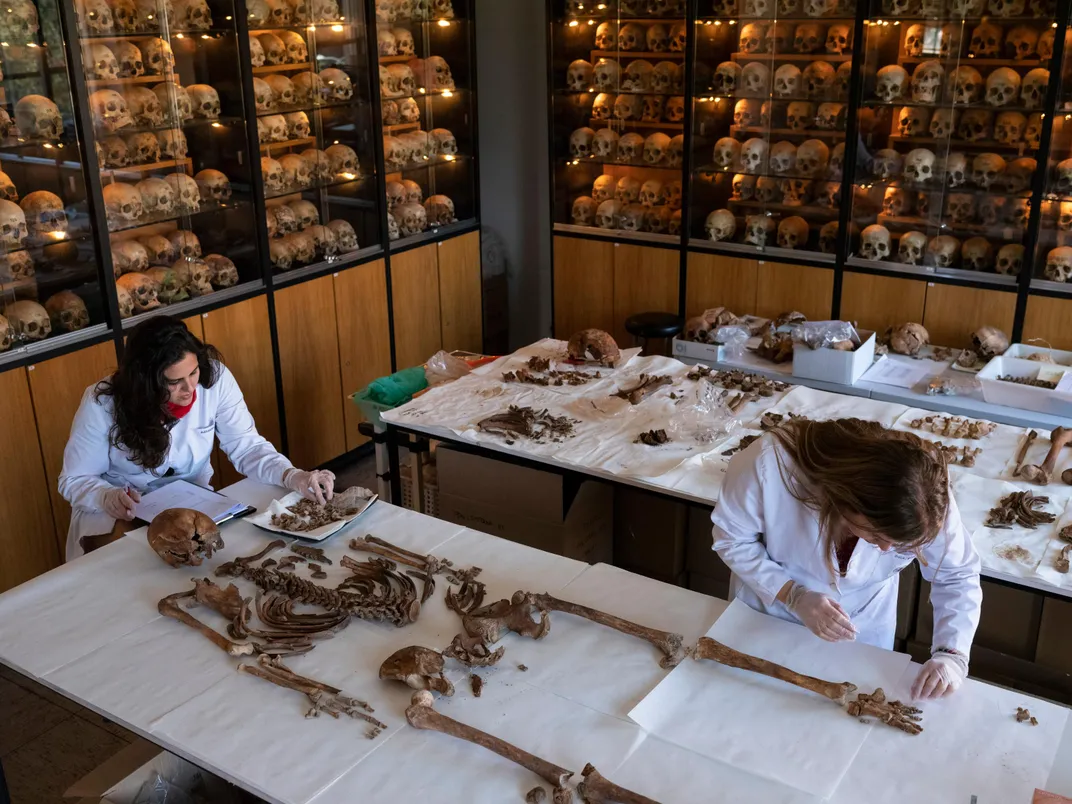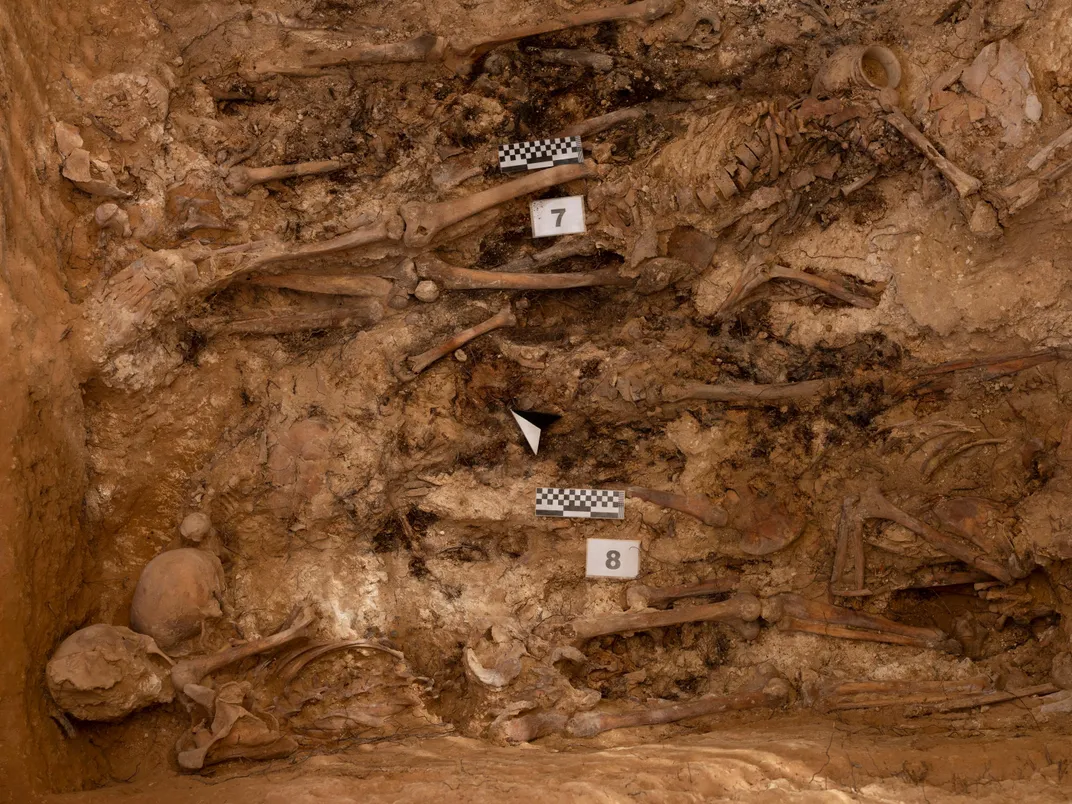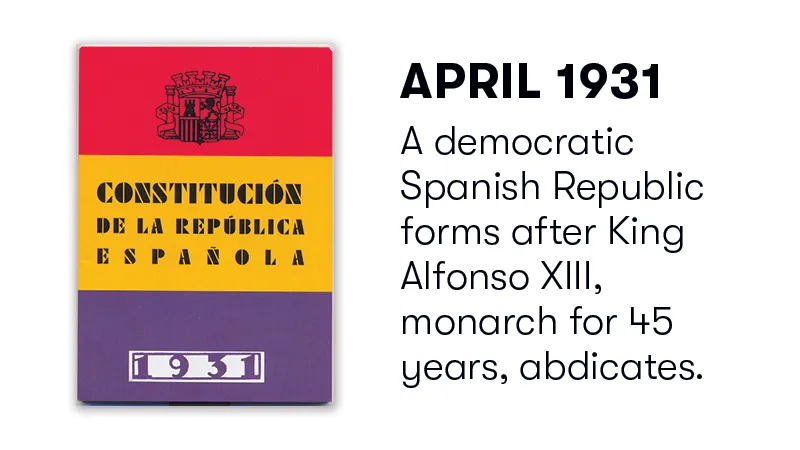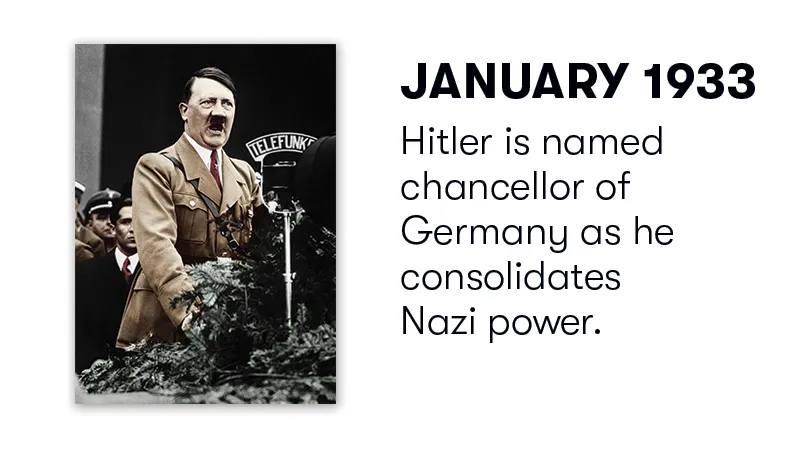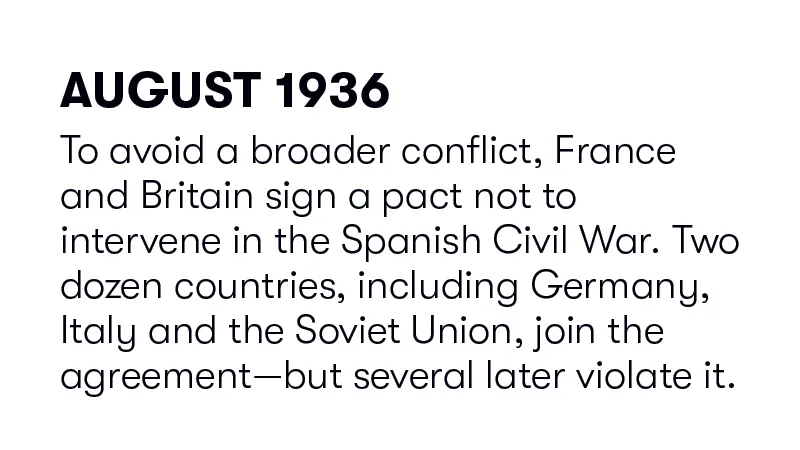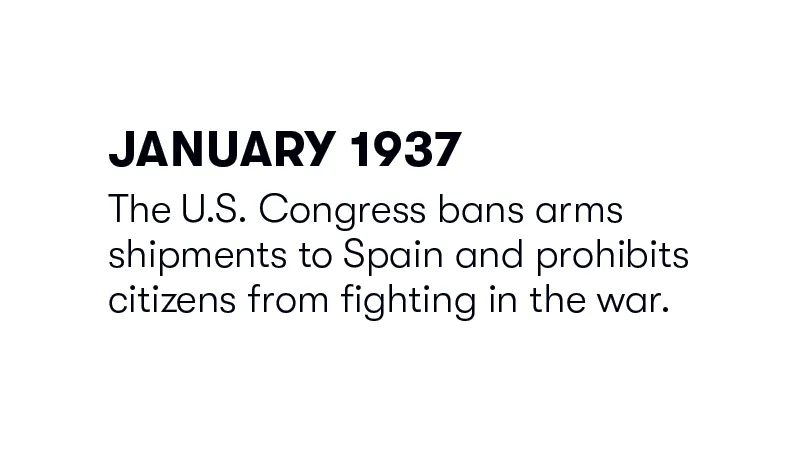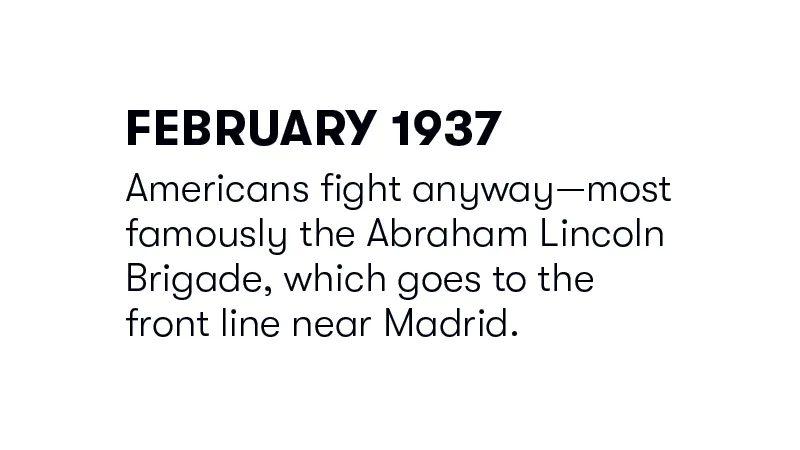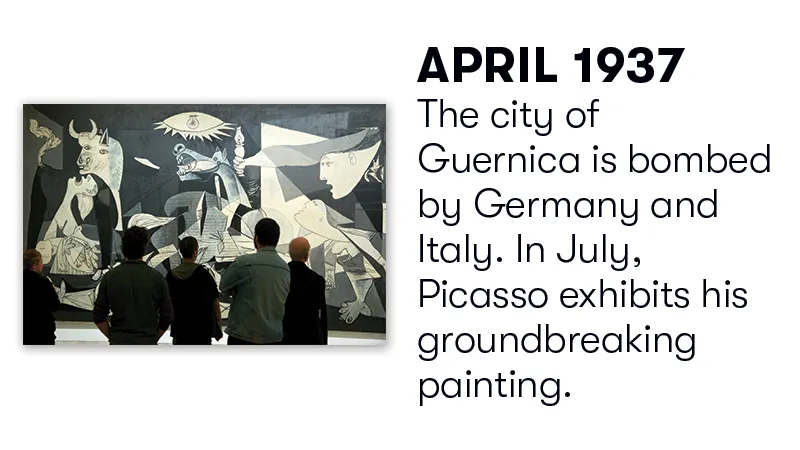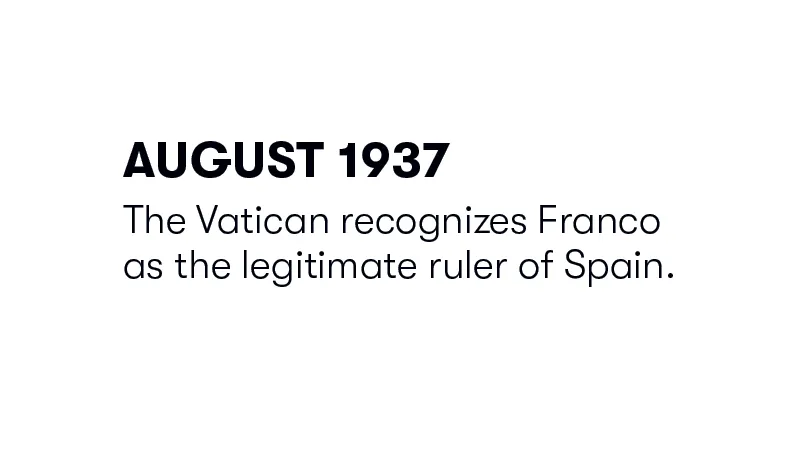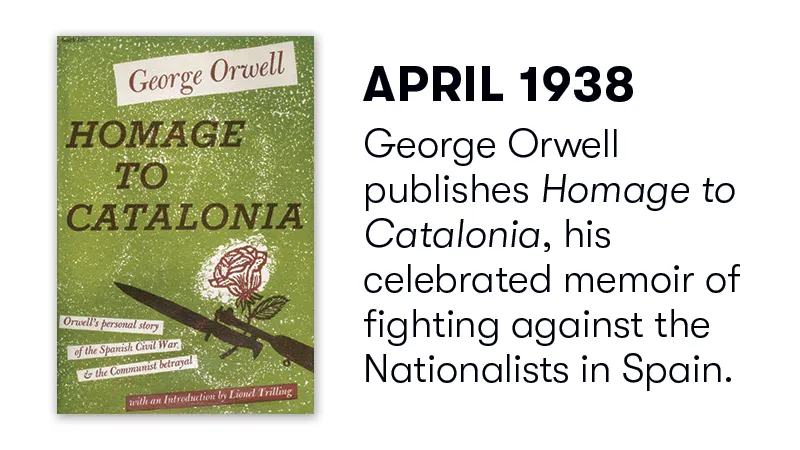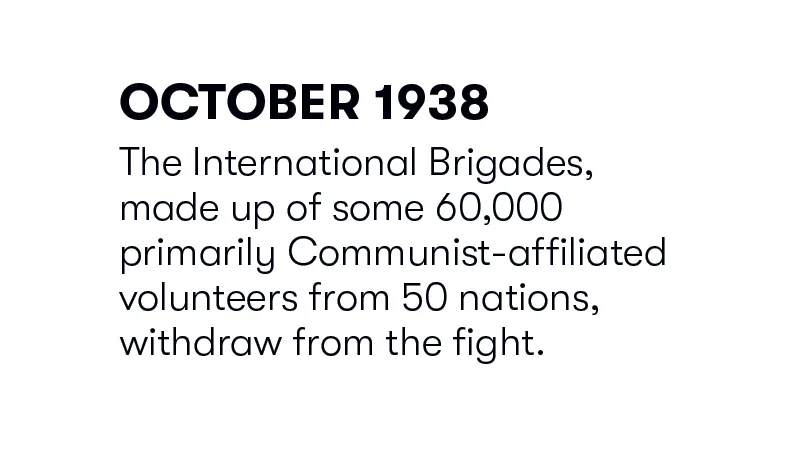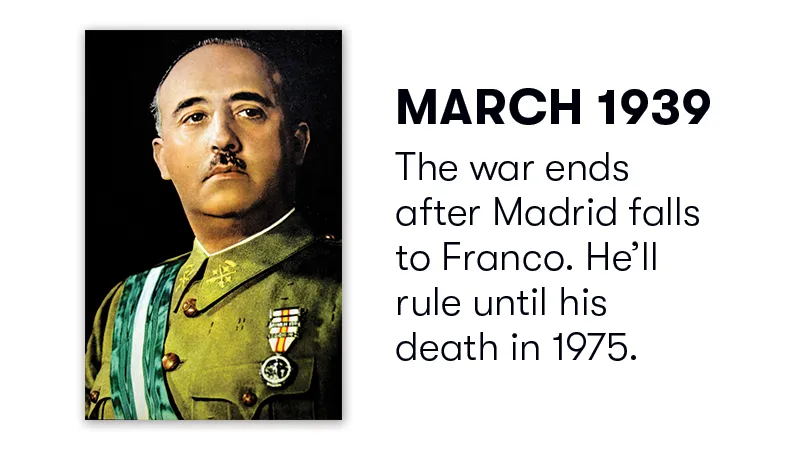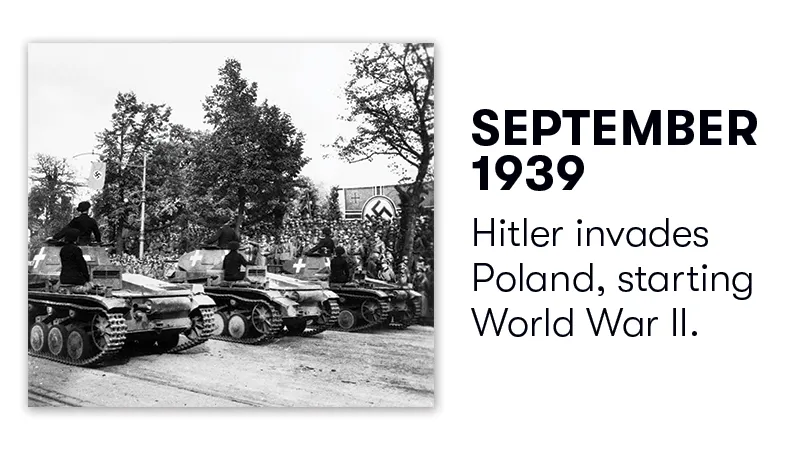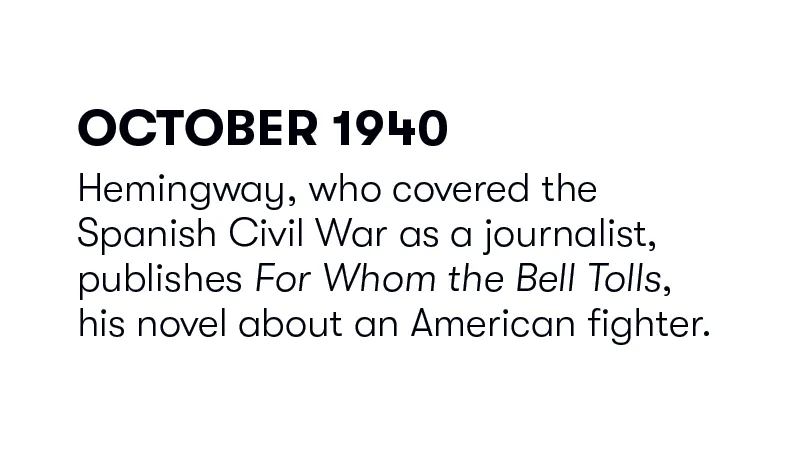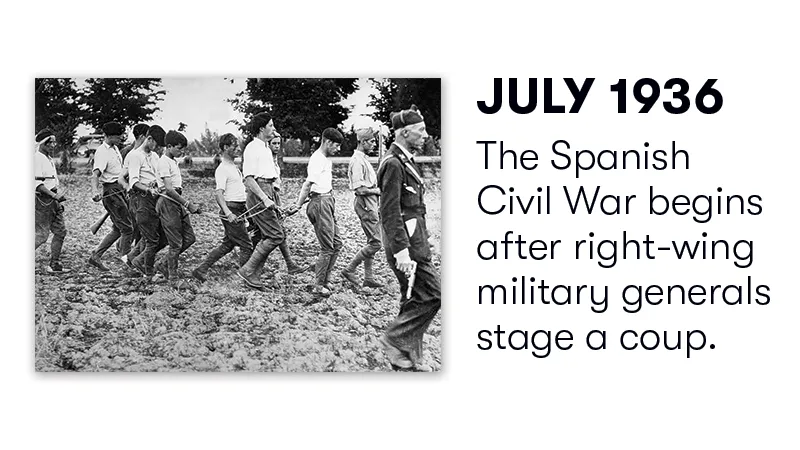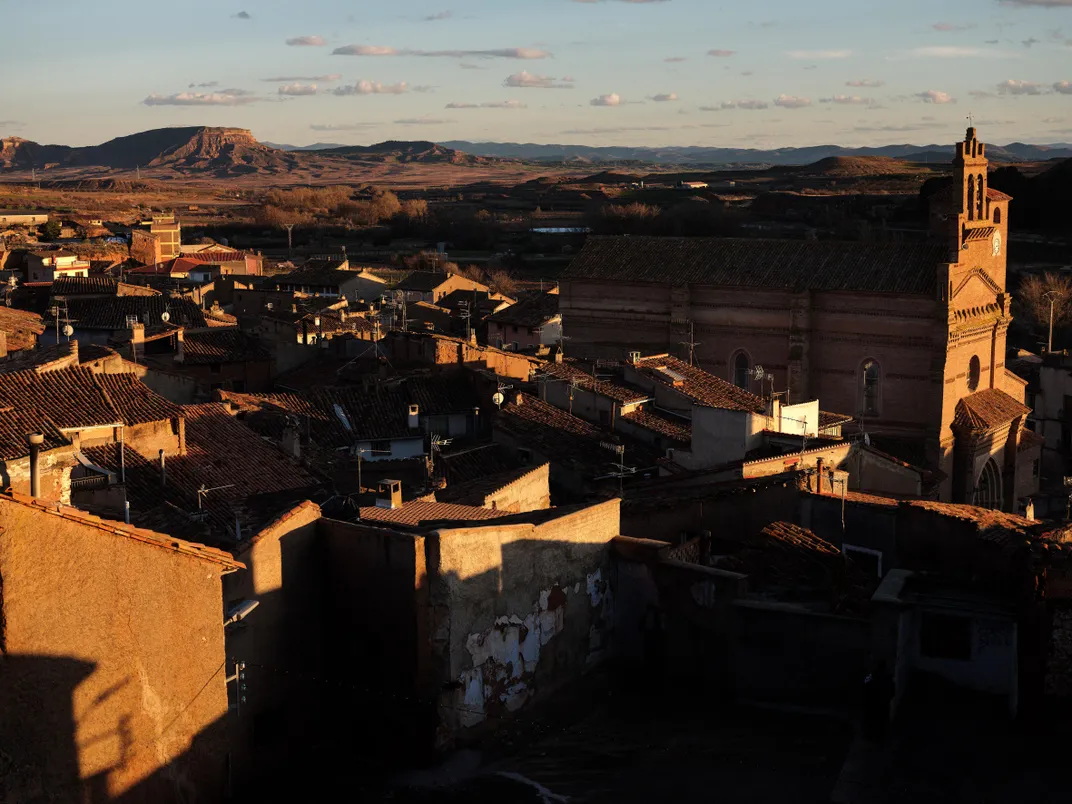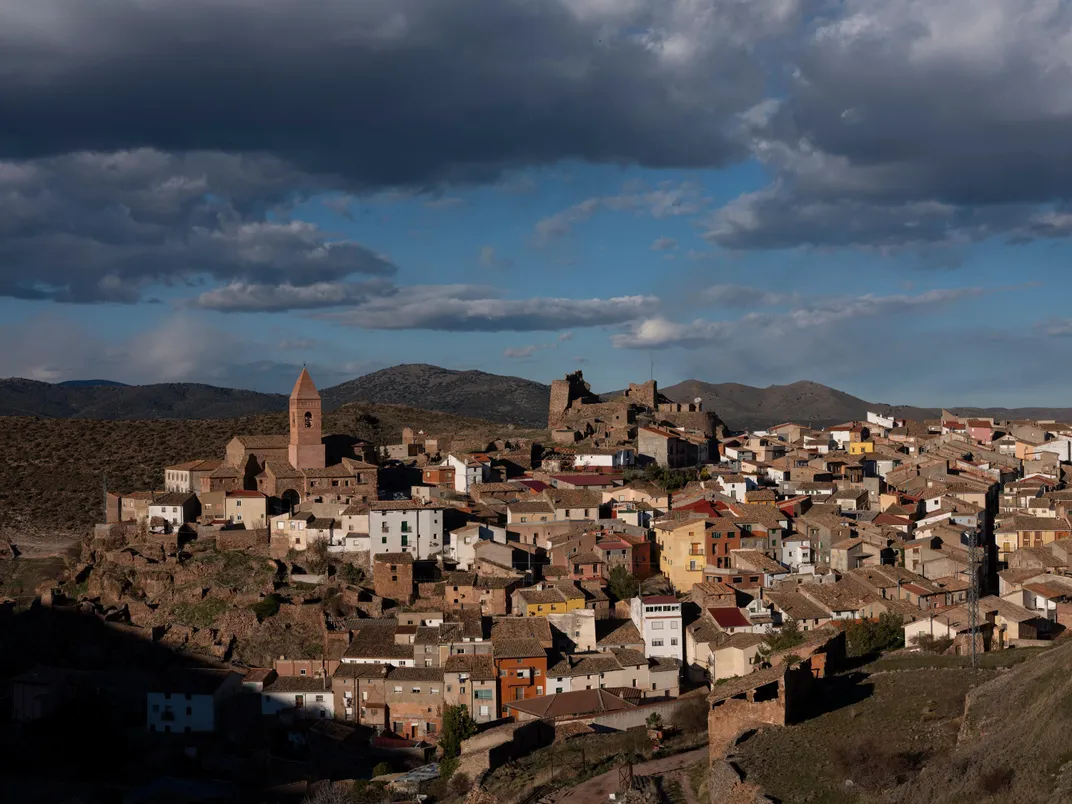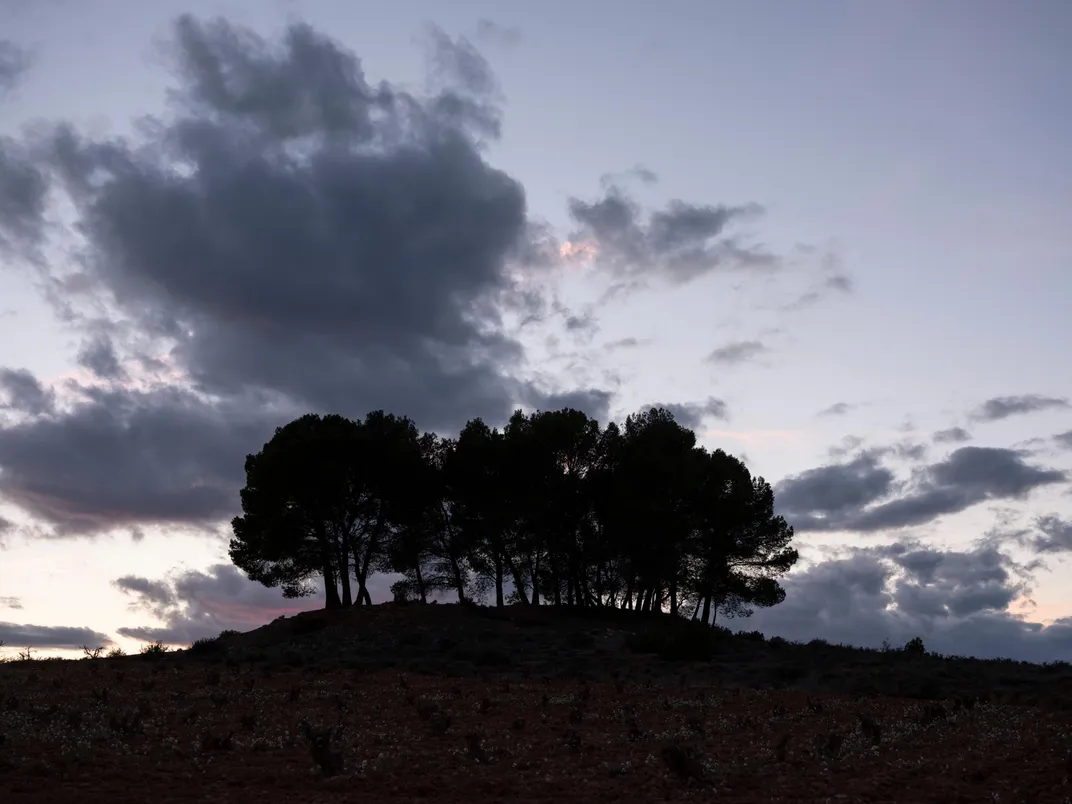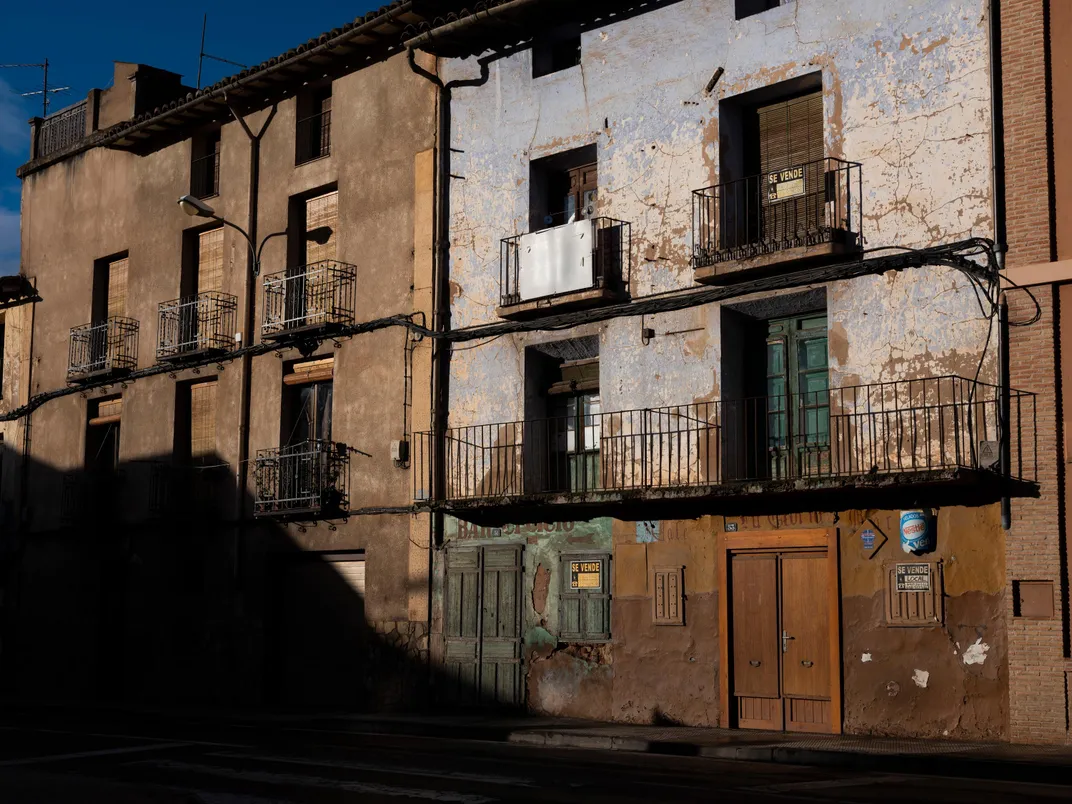The Battle Over the Memory of the Spanish Civil War
How Spain chooses to memorialize Francisco Franco and the victims of his authoritarian regime is tearing the nation apart
/https://tf-cmsv2-smithsonianmag-media.s3.amazonaws.com/filer/3e/f3/3ef330ab-6316-49e5-91b7-21432b8e77e7/kulaug2018_l01_spanishcivilwar.jpg)
Editor’s Note, October 24, 2019: Earlier today, Spanish authorities exhumed the remains of dictator Francisco Franco from the Valley of the Fallen, the Catholic basilica and tomb he built for himself during his 40-year rule. The site is also home to tens of thousands Civil War dead from both sides of the conflict, making it one of the largest mass graves in Europe. The Spanish government’s contested decision comes after years-long national controversy over the fate of the mountainside basilica and tomb, which was the subject of a Smithsonian magazine story in 2018.
Even amid the chaos of the uprising’s first hours, Manuel's capture was a priority. In his small village of Villarroya de la Sierra, Manuel was beloved for his work as the town veterinarian, but he was also the founder of the local chapter of an anarchist labor union. It was evidence enough for a priest, Father Bienvenido Moreno, to condemn Manuel as “the cause of all the evil that has come to the people.”
They found him on the outskirts of town, where he had gone to help a friend with the summer harvest. His location was betrayed by his bicycle, which the soldiers spotted near the side of the road. They snatched Manuel from the fields and drove into town with their new prisoner on display in the bed of a truck.
The eldest of Manuel’s four children, Carlos, who was barely a teenager, gave chase, following the truck along Villarroya de la Sierra’s winding streets, past the central square and the red brick church. “Stop following us,” one of the soldiers told the boy, “or we’ll take you, too.” Carlos never saw his father again.
Manuel was transported to the nearby town of Calatayud, where he was held in a makeshift prison on the grounds of a church. A few days later, he was taken to a ravine on the edge of town called La Bartolina—“the dungeon”—and executed by firing squad. His body was dumped in an unmarked mass grave.
**********
Purificación “Puri” Lapeña never knew her grandfather, but growing up she’d heard stories about him. Her father, Manuel Jr., told Puri that her grandfather was quick-witted and conscientious, a doting parent and a reliable friend. He told her about the time that one of Manuel’s customers, unable to pay for his services, gave Manuel a beautiful plot on a hillside as compensation. Manuel could have sold the land, but instead he planted a grove of trees and carried benches to the hilltop, so that townspeople could sit and enjoy the view. Manuel Jr. also told Puri about her grandfather’s disappearance, and who he felt was responsible. When Gen. Francisco Franco appeared on television, Manuel Jr. would go silent, then point and say quietly, “That is the man who murdered my father.”
When Puri was 16, her father borrowed a car and drove her to La Bartolina, where they stood quietly in the sunshine, looking out over the ravine. He wanted Puri to see the place for herself. Even as a girl, Puri knew that these stories were to be kept private, never shared with anyone outside the family.
When the Spanish Civil War began, in 1936, fascism was on the march across Europe, as a new breed of strongman leader emerged from the horrors and economic ravages of the First World War and the Great Depression. The war in Spain played out like a dress rehearsal for the global cataclysm that was to come—the first pivotal battle in the struggle between ascendant right-wing authoritarianism and beleaguered liberal democracy. Each side was aided by ideological allies from across the continent and beyond. When, for example, the Republican stronghold of Guernica was bombed to ruin in 1937 (the subject of Picasso’s famous antiwar painting), the assault was carried out at Franco’s request by warplanes that Hitler and Mussolini had dispatched. Thousands of volunteers also went to Spain to fight on the side of democracy, including nearly 3,000 Americans.
The conflict ripped Spain apart. Neighbors turned on one another, brothers killed brothers, and thousands of teachers and artists and priests were murdered for their political sympathies. The wounds left by the conflict never quite healed. To this day, Spanish politics tend to cleave along the lines established during the civil war: the conservative, religious right, heirs and defenders of Franco, against the liberal, secular left, descended from the defeated Republicans.
By 1939, after Franco’s Nationalists had conquered the last Republican holdouts, an estimated 500,000 people were dead. More than 100,000 were unaccounted for, “lost” victims who, like Manuel Lapeña, had been piled in mass graves. Both sides had committed atrocities; there was no monopoly on suffering. But in Franco’s four decades of rule, he made sure that the war was remembered in simple terms: The dangerous Republican anarchists had been pure evil, the enemies of the people. Anyone who said differently risked imprisonment and torture. For families like Puri’s, silence was a survival strategy.
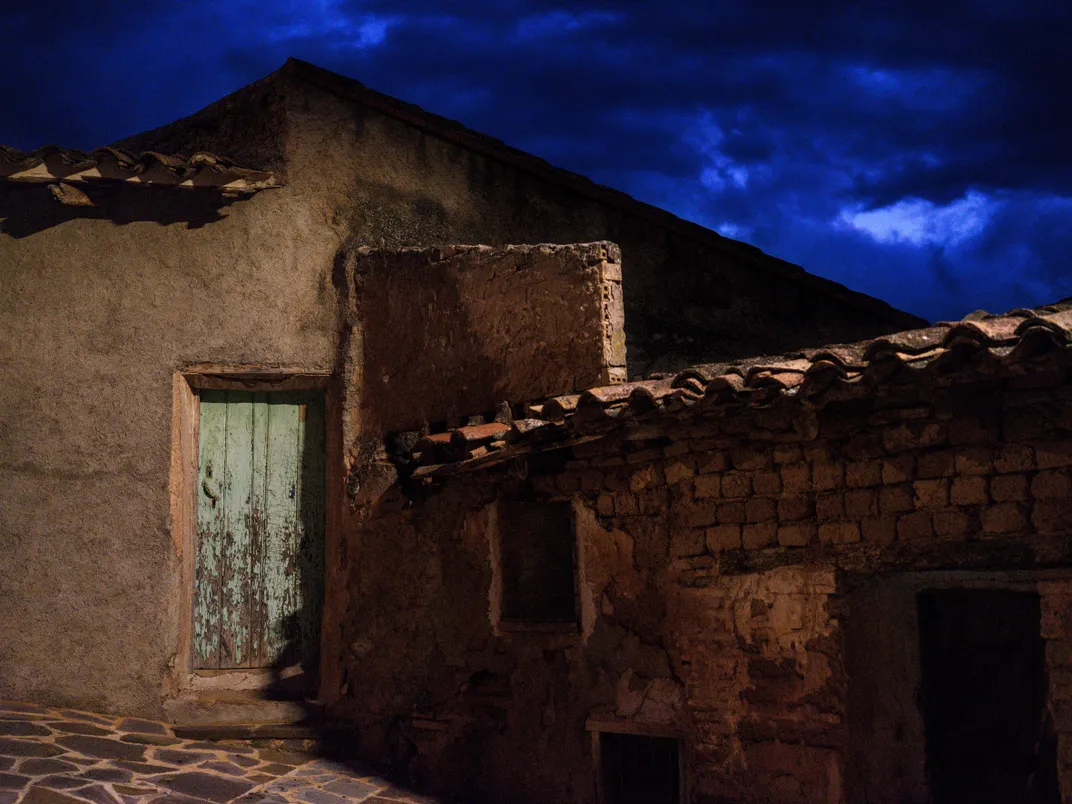
When Franco died, in 1975, the country faced a choice. In countries such as Germany and Italy, defeat in World War II had forced a measure of reckoning over the crimes committed by fascist regimes. Spain, which remained neutral during the war despite secret cooperation with the Axis powers, chose a different path, cementing its legacy of silence through a political arrangement known as the Pact of Forgetting. In the name of ensuring a smooth transition to democracy, the country’s rightist and leftist parties agreed to forgo investigations or prosecutions related to the civil war or the dictatorship. The aim was to let the past stay buried, so Spain could move on.
Puri tried to do the same. She had a happy childhood, as normal as the times allowed. Money was scarce, but her parents—her father was a postman and accountant, her mother a tailor and saleswoman—worked hard to provide for Puri and her three younger siblings. Puri attended Catholic and state schools, and as an adult she found a job disbursing pensions and other government benefits at the National Institute of Social Security. She met a friend of her sister’s named Miguel, a man with a bulldog face and a wry sense of humor. The couple married in 1983, had a daughter, and settled in Zaragoza, where some of Puri’s relatives had gone after Manuel Lapeña’s disappearance.
Life went on, but Puri always wondered about her grandfather. It was impossible not to, as the civil war shaped her entire life: One aunt could not speak of Manuel without crying inconsolably. Puri’s uncle Carlos, who as a boy had chased his father’s killers through the streets, became a devoted rightist, and refused to acknowledge what he’d seen until he finally broke down on his deathbed. Puri’s mother, Guadalupe, had fled her hometown in Andalusia after her own father and 8-year-old brother were killed by Franco’s troops.
When Puri first began looking for Manuel, she couldn’t have known that the search would open an unprecedented new front in the war over Spain’s historical memory. It started simply enough: In 1992, Puri read a book called The Hidden Past, written by a group of historians at the University of Zaragoza, which traced the violent rise and legacy of fascism in northeast Spain. Included in the book was a list of all the Spaniards whom the authors had identified as “disappeared” during the civil war.
There, Puri saw it: Manuel Lapeña Altabás. She had known since childhood about her grandfather’s murder, but the story always had the feel of a family legend. “When I saw the names, I realized the story was real,” Puri told me. “I wanted to know more. What happened? Why? Until that moment, there were no documents. Suddenly it seemed possible to find him.”
Spain in Our Hearts: Americans in the Spanish Civil War, 1936–1939
For three years in the 1930s, the world watched, riveted, as the Spanish Civil War became the battleground in a fight between freedom and fascism that would soon take on global proportions.
**********
Puri began scouring local government archives, looking for any information she could find about her grandfather’s death. She had just a name to go on, and in years of searching she turned up only a handful of documents. No one wanted to discuss Spain’s mass graves, much less track down a particular body.
For decades the graves went unacknowledged: no markers, no plaques, no memorials. When mourners did visit them, it was in secret, like Puri and her father at the ravine. In the years immediately after Franco’s death, a small number of Spaniards quietly began to reclaim the remains of their disappeared loved ones with little more than hands and shovels. But those exhumations were scattered and unofficial, kept out of public view by fear and shame. There was no way to know whether the bodies discovered by families actually belonged to them.
By the early 2000s, though, the silence was beginning to give way. A social movement took root as archaeologists, journalists and ordinary citizens, led by a sociologist named Emilio Silva, sought to document and unearth mass graves across the country. In the span of a few years, thousands of bodies were recovered. The awakening was driven in part by advances in forensic anthropology. With new tools like DNA sequencing and skeletal analysis, forensic specialists could identify remains and match them to living relatives. The search was no longer an exercise in hopeful guesswork: Now the bodies had names and loved ones they had left behind.
That was how Puri came to stand in the ravine of La Bartolina, decades after her first visit, on a bright, warm day last fall. Despite its bloody history, the site is easy to miss. From the highway, the only marker is a run-down building that reportedly serves as a brothel, and a thin, dusty footpath leading into the hills. The ravine is bone-dry and overgrown with shrubs. There’s garbage in every direction, tossed about by the wind that whips through the valley. “An ugly place for ugly things,” Puri told me, as we kicked through the dirt and debris.
Now 60, Puri has gently curling gray hair and wears simple rimless eyeglasses. She speaks quietly and carefully, with a self-possession that is almost regal, but when she gets excited, or angry, her voice rises to a rapid, insistent clip. You can see from old photographs that she inherited Manuel’s taut, frowning lips and his round blue eyes.
Today there’s a wide gully in the heart of the ravine, carved by flash floods and the earth-moving machines that arrived years ago to turn the site into a garbage dump. Puri believes that the executions happened against the far wall of the ravine, just before a bend in the riverbed that hides most of the valley from view. On a visit in 2004, she found clusters of spent shell casings there, and pockmarks in the dry orange walls from the bullets that had missed, or gone through, their targets.
“Whenever I think of my grandfather, and the other men lined up, I can’t help but wonder about the same questions,” Puri said, as she looked at the scarred wall. What was he wearing? What was he thinking about? Did he say anything at the end? “I think he must have been incredulous. It was the very first days of the war, and he probably couldn’t believe they would actually kill him for doing nothing wrong. I hope he was thinking of his family.”
In 2006, Puri visited the Calatayud cemetery, not far from the ravine. Dozens of people from Manuel’s hometown had been rounded up and shot there, including Manuel’s brother, Antonio. If Manuel’s body had been moved, she reasoned, perhaps it was taken here. As she wandered the tree-lined paths, looking for graves from the civil war era, a local resident approached and asked what she was doing. When Puri told the man about her grandfather, he replied: Oh, you won’t find any bodies here. They were dug up and moved decades ago. The man had seen it himself, and he knew where the bodies were taken: El Valle de los Caídos. The Valley of the Fallen.
Puri was elated—and crestfallen. Finally, she had a clue to follow. But she knew that if Manuel was truly in the Valley of the Fallen, she would never get his body back. The Valley was untouchable.
**********
The Valley of the Fallen was the brain-child of Franco himself. He declared his intention to build the site, a towering Catholic basilica and civil war memorial outside Madrid, in 1940, one year after the end of the civil war. The Valley would be a “national act of atonement,” Franco said, and a monument to reconciliation. But from the beginning it was clear the Valley would be something else entirely. Built in part by Republican political prisoners, the basilica would in time hold only two visible tombs: one for Franco, and one for the founder of the Falange, a far-right political party that helped propel the Nationalists to power. Construction took nearly 20 years. A few months before the site’s inauguration, in 1959, Franco ordered municipalities from across Spain to send remains from mass graves, to enhance the Valley’s size and grandeur. Whether the graves held Republicans or Nationalists didn’t matter. In death, Franco would watch over them all.
In total, 33,847 bodies were moved, largely in secret and without the knowledge or consent of relatives. But it was impossible to hide the process entirely, and some people, like the man Puri met in the Calatayud cemetery, had witnessed it. Local officials had also kept some records, including a report stating that on April 8, 1959, nine pinewood caskets containing 81 bodies from Calatayud arrived at the Valley of the Fallen and were placed in a crypt inside the basilica. The fact that the bodies were unidentified indicated that the people inside the caskets had been killed by Franco’s troops. When Nationalist remains reached the Valley, they arrived in individual coffins with their names inscribed above plaques designating them as “martyrs.”
Decades after Franco’s death, the Valley is Spain’s most potent and controversial symbol of the civil war and the dictatorship that followed. For many Spaniards, the site embodies immense loss and unspeakable suffering; for others, like the far-right supporters who flock to the site each year to celebrate Franco’s birthday, it is a fitting tribute to Spain’s most consequential leader, and a monument to a persistent strain of Spanish nationalism. Puri visited for the first time in 2010, after learning about the transfer of bodies from Calatayud. Even if Manuel’s body had been among them, officials told her, “You won’t find what you’re looking for.”
She kept returning anyway, a stubborn gesture that was half pilgrimage and half protest. Still, she never felt comfortable visiting. “People don’t understand that this is a sinister place,” Puri said, as we drove toward the Valley one afternoon. The basilica’s imposing cross, which stands nearly 500 feet tall and seems to dwarf the nearby mountains, was coming into view. I asked Puri what she felt during her visits. “Anger, humiliation, fear,” she said. On the car seat beside me was a transparent orange folder containing all the photographs, records, certificates and other documents Puri had accumulated in the course of her search. On top was a handsome portrait of Manuel, taken not long before he was killed.
The entire Valley complex is awesome and intimidating, just as Franco intended. A grand esplanade offers sweeping views of the surrounding countryside, and two immense stone colonnades channel visitors toward a bronze entryway. The basilica itself is an astonishing feat of engineering, carved 860 feet directly into the granite of the mountain. When Pope John XXIII visited in 1960, he consecrated only the innermost portion of the basilica; if he had consecrated the entire space, it would have eclipsed St. Peter’s in Rome.
When we arrived, there was already a long line of buses and cars waiting to enter. National Heritage, the government agency responsible for the site, had offered relatives of the deceased free entrance for life, but Puri rejected the offer. She felt that accepting would lend her consent to Manuel’s interment. She’d agreed to visit the site with me only on the condition that I pay the entrance fee for both of us.
The Spanish government has tried, fitfully and unsuccessfully, to settle the issue of the Valley, or at least to alter the site to make it palatable to all Spaniards. In 2004, a left-leaning prime minister introduced the first legislation to take on the legacy of the war and dictatorship. In 2011, he appointed an Expert Commission for the Future of the Valley of the Fallen, to recommend steps for converting the site into a “memory center that dignifies and rehabilitates the victims of the civil war and subsequent Franco regime.” Even to supporters, it seemed a near-impossible goal, doomed either to fail outright or to be reversed as soon as a conservative government took office. One prominent historian at Complutense University of Madrid, foreseeing no hope for success, rejected his invitation to serve on the commission. “I believe that what the government intends to do with this monument is utterly impossible to realize,” he said. “The only way to alter the meaning of this place would be to demolish it.”
It’s easy to see why he felt that way. Inside the basilica, the Valley’s meaning is inescapable, inspiring fear and awe in equal measure. “Artistically, it’s a perfect fascist monument,” Puri said, as we stood at the entrance. “It’s cold and empty and imposing. The statues look down on you.”
Past the entryway, in a dark, domed antechamber lit by flickering lights styled as medieval torches, stand two statues of angels with swords in hand. The angels were forged from melted cannons used in the civil war, and their blades are thrust down into the walkway as a sign that the battle has ended and peace has arrived. But the statues also convey a more menacing message, said Francisco Ferrándiz, an anthropologist at the Spanish National Research Council and member of the Expert Commission. “It’s not hard to notice that the swords can be picked up again,” he said.
Lining the basilica’s black marble nave are eight huge tapestries, each one depicting a scene from the Bible. They are a procession of death and wrath, God at his most vengeful: hellish beasts and exterminating angels, visions of apocalypse that seem to grow darker and more frightening the deeper you walk into the belly of the mountain. Just before the altar, where the nave gives way to wooden pews, eight towering granite monks keep watch. Like the angels that precede them, the monks, positioned near the top of the vaulted ceiling, rest their hands on immense swords, and they peer down with eyes eerily hidden beneath the hoods of their robes.
The aura of holy wrath culminates at the central altar. On the near side of the altar is the grave of José Antonio Primo de Rivera, the founder of the Falange. On the far side is Franco’s grave, set into the floor beneath a simple stone tablet bearing his name and a cross. Atop both lie fresh flowers, replaced each week by the National Francisco Franco Foundation.
A golden mosaic above the altar depicts Franco’s soldiers beside cannons and fascist flags, heirs to Spain’s long history of Christian martyrdom. Franco viewed the Spanish Civil War as a new Crusade waged by loyal believers against Republican atheists. “National Catholicism” was a pillar of his governing ideology, and the Catholic Church an essential ally in his rule.
Walking through the silent basilica, it’s easy to forget that you’re in the middle of an immense burial ground. Apart from the two fascist tombs, the remains are hidden in eight crypts lining the walls of the nave and two small chapels set off to the sides of the altar. Together they hold tens of thousands of dead bodies, stacked three and five stories high.
**********
After Puri's first visit to the Valley, she reached out to a lawyer named Eduardo Ranz, to see if there was any way to press for the recovery of Manuel’s body and that of Manuel's brother, Antonio. Ranz was young—barely out of law school—but he had already been working on cases related to historical memory for several years, including exhumations. In Puri’s quest to exhume her grandfather from the Valley of the Fallen, Ranz saw an opportunity to confront one of the final taboos of Franco’s legacy.
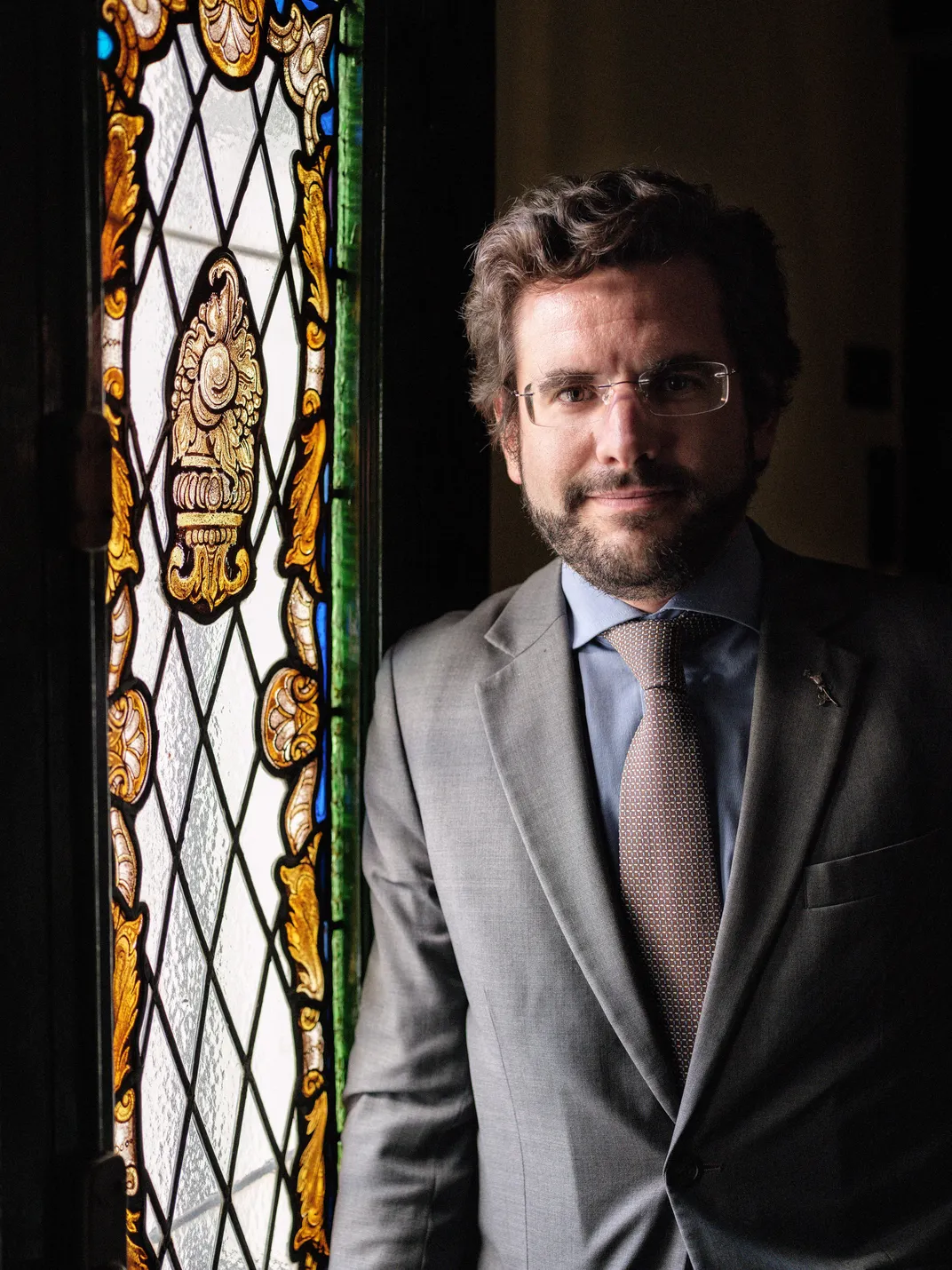
In 2012, Ranz filed a lawsuit seeking permission to remove the Lapeña brothers’ remains for reburial. The case was audacious, unprecedented and potentially transformative. But despite the political progress of the previous decade, it was not a promising moment for advocates of reform. A year earlier, a conservative government had swept into power, vowing to freeze or roll back many of the initiatives championed by a long-serving leftist government, including state support for exhumations. The report of the Expert Commission for the Future of the Valley of the Fallen, delivered to the government nine days after the election, went unheeded.
Puri’s lawsuit was only the beginning of a judicial and political odyssey. The case wound its way through six courts in four years, including the Constitutional Court of Spain and the European Court of Human Rights. Initially, Ranz tried to file the suit in criminal court; when the court rejected the case by virtue of Spain’s amnesty law for Franco-era crimes, he pivoted, invoking an obscure, 19th-century civil statute that allowed family members to claim the property of their deceased relatives.
The gambit worked. In May 2016, a judge ruled in Puri’s favor: Manuel and Antonio Lapeña had the right to a dignified burial, even if it required their exhumation from the Valley. There was, the judge wrote, a “high probability” that their bodies were among the anonymous remains shipped to the Valley. He ordered that researchers be given access to the tombs in order to conduct DNA tests and identify the brothers for exhumation.
It was a stunning, historic victory and, at first, National Heritage said that it would “scrupulously” comply with the judge’s orders. But the ruling provoked fierce opposition from the Catholic Church and conservative groups, which decried the opening of the tombs. Even if the Lapeñas could be found and identified, they argued, doing so would require workers to disturb the remains of thousands. Meanwhile, the government began to order report after report in the name of prudence and caution—structural assessments of the tombs, forensic data on the state of the bodies, inspections for water damage, and more.
When I visited last fall, more than a year after the judge’s decision, the process was still mired in delays. Ranz, who was once elated by the case’s prospects, now seemed dejected. “The reality is that the bodies are still there,” he told me. For Puri, the wait is agonizingly personal: her mother passed away in December, and her father, Manuel Jr., is now 94 years old, his last memories of childhood quickly slipping away. Puri’s hope is to bring home her grandfather’s remains while her father is still alive.
The bodies from Calatayud were placed in the Chapel of the Sepulcher, a small annex of concrete and marble located to the right of the altar. Above an ornate wooden door that leads to the crypt is a black iron cross and the words “Fallen, for God and for Spain, 1936 – 1939, RIP.”
Inside the chapel, Puri stood quietly facing the door. Except for a few visitors wandering in and out, she had the space to herself. When no one was looking, she reached out and tried the heavy metal doorknob, but it was locked. Then she turned to leave. “He wouldn’t want to be here,” she said. “It’s a sad, terrifying place.”
**********
Behind the basilica, at the base of the towering cross, is the Benedictine Abbey of the Holy Cross of the Valley of the Fallen. The resident monks are the Valley’s guardians, and the caretakers of the dead. They lead daily Mass in the basilica and run a bustling guesthouse and a primary and secondary school.
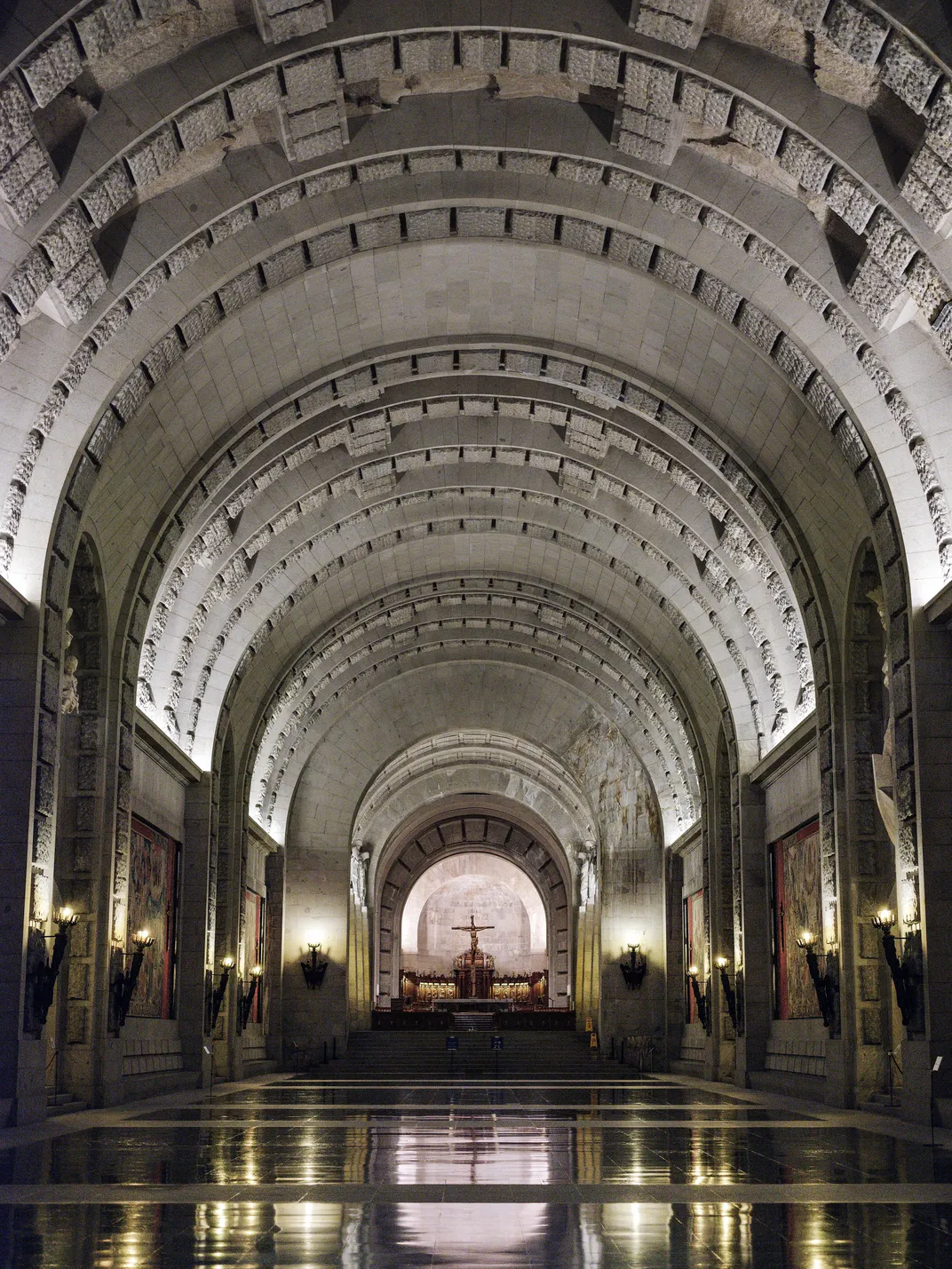
The monks are at the center of the Valley, both physically and politically. While the majority of the site is owned and administered by the Spanish state, the state cannot enter the basilica without the Church’s cooperation. Even the judicial decision in Puri’s favor was not enough to compel the monks to comply.
The prior-administrator of the abbey is an especially polarizing figure named Father Santiago Cantera. Not long after the ruling, he lodged a formal appeal with the Constitutional Court, on behalf of families who did not want their relatives’ remains to be touched. It seemed to him that those families had the same rights as Puri, the same stake in determining the future of the Valley. Among those involved in the movement to address Spain’s legacy of silence, Cantera gained a reputation as an implacable opponent. Before I visited the Valley, hoping to speak with him, I asked Puri what the biggest obstacle was to gaining possession of her grandfather’s remains. She didn’t hesitate. “The man you’re going to meet.”
Though he is the public face of a national controversy, Cantera is notably withdrawn. He has shunned news media interviews, and when the Spanish Senate recently summoned him to explain the abbey’s refusal to comply with the judicial order, he declined to appear, citing his “duties as the head of the monastery” and his “religious condition.”
Even at the abbey, he is difficult to reach. When I arrived for our meeting, the receptionist told me Cantera was not available. The monks were at lunch, she said, and could not be disturbed. After eating they would go immediately into prayer. She suggested I return on another day. I told her I would be happy to wait. I stood at the desk, smiling at the guesthouse visitors as they came and went. Finally, after close to an hour, the receptionist told me she would try to reach Cantera. She dialed a few numbers on a bulky corded phone, gave an exaggerated shrug, and hung up. It went on like that for another half-hour until she tried another number, this time reaching Cantera immediately, and relayed that he was free to meet. He was waiting in a room just across the courtyard.
Cantera surprised me even before he spoke. After the warnings and general air of mystery, I expected to find a crusty, humorless disciplinarian. But the man in a simple black habit who met me was young, with kind eyes, a boyish face, and a light shading of stubble. After we sat down on hard chairs in a simple room, he leaned forward, his elbows resting on his knees, eager to talk. “Many people come here looking for peace,” he said.
Cantera arrived at the Valley circuitously. Both of his parents were educators, his father a professor of French studies and his mother a history teacher, and all four of his brothers went into university life. Cantera followed the same path, earning a doctorate in medieval history and taking up a teaching position at a university in Madrid. He had a girlfriend, and he thought about getting married and having children. But the monastic life, he told me, “hovered around me since my childhood.” A visit to an abbey deeply moved him, as did meeting with the monks and nuns who lived there. After he completed his doctoral thesis, about the Carthusian religious order, a Benedictine monk invited him to a meditation retreat at the Valley. It felt natural.
The role of abbot has not come easily to Cantera. By nature he is shy, and his favorite part of monastic life is the space for thinking. (He has written 17 books on Catholic subjects.) “I am not a person who likes to be in charge, or to make decisions, or to impose myself,” he said. He accepted the role of abbot “as a service to the community and to other monks, because it is God’s will, and out of obedience.”
The biggest adjustment, though, has been learning to ignore the caricatures drawn by polemicists on both the left and the right. Like all Spaniards, Cantera knew about the controversies surrounding the Valley, but even today, more than a decade after joining the abbey, he seems bewildered at the rancor he inspires. “We find ourselves in the middle of two positions that have the same rights as each other,” Cantera said. “Everything I say can be misunderstood, and every position we take is bad. It will always upset someone.” And people on both sides of the argument don’t seem to grasp the nature of the monks’ responsibility. “We are not the owners of the bodies, we are only their custodians,” Cantera said.
Dawn of a Dictator
Franco’s brutal rise to power was a first step on the march to world war.
Cantera believes it is unlikely that Manuel’s remains could be identified. Manuel’s name does not appear in the Valley’s records, and if the body is there, it’s among dozens of others from Calatayud, in a stack of bones sealed in a crypt untouched for decades. The remains have decomposed, and it may not be evident where one body ends and another begins. More important, Cantera finds the very idea of exhumations deeply upsetting. The point of the Valley, he said, is precisely that “the corpses are intermingled, Nationalists and Republicans are together.” Whichever side they fought for, in the Valley all are buried as Spaniards.
I heard the same argument echoed by Pablo Linares, the founder of the Association for the Defense of the Valley of the Fallen, a conservative group that lobbies on behalf of keeping the Valley unchanged. “The Valley is already a place of reconciliation and peace,” Linares said. “It is a place where former enemies are buried side by side, enemies who fought in the worst kind of war—a war between brothers.” Linares told me that dozens of families with relatives buried in the Valley have contacted him anguished at the prospect that their loved ones will be disturbed. “I have respect for Puri and for her family,” Linares said. But he pointed out that her grief is not unique. “I also have respect for all the Puris in this country,” who Linares feels must include the descendants of Nationalists and Republicans alike.
For his part, Cantera has floated ideas for compromise, such as inscribing the names of every person buried in the Valley on the exterior portico or displaying the names on a digital screen inside. He has even talked about ways to disperse the cloud of fascism that hangs over the monument, either by removing Franco’s remains outright or by bringing in the body of a famous and symbolic opposite, like Federico García Lorca, the leftist playwright and poet executed by fascist troops in 1936. (This idea, too, faces obstacles: Lorca’s body has never been found.)
Despite numerous proposals, no significant change has come to the Valley, and the conservative party has been determined to keep it that way. “Let the dead bury the dead,” one conservative senator has said. The government must focus on “problems of the living.” It’s never that simple, of course, not anywhere, and certainly not in Spain. The dead are silent, but a legacy of violence and loss can echo for generations. It’s no coincidence that Spain is wracked by a separatist movement in Catalonia, the epicenter of the Republican resistance against Franco and the province his regime then repressed most severely.
“We’re still in confrontation,” Cantera said. “Some people don’t want to close old wounds.”
**********
When Puri wants to visit her grandfather, she doesn’t go to the Valley. Instead she drives to Villarroya de la Sierra, the small town where he lived. It’s there, Puri says, where Manuel is most alive. The red brick building where he had his veterinary clinic is still standing, right next to the church on the town square, and down the street from the house where he was born and raised. Old women shuffling down the road stop and wave at Puri, calling her “the Lapeña girl” and telling her how much she looks like her mother. On a hill is the grove of trees that Manuel planted for townspeople to enjoy. When he disappeared, the trees were saplings; now they’re thick and towering. “No one takes care of them,” Puri says. “They just grow and thrive by themselves, a living memory of who he was.”
At the end of an unpaved road outside town there’s a small municipal cemetery. Inside the wrought-iron gate, a few steps from a simple marker honoring the town’s civil war dead, lies the Lapeña family plot. On the day we visited, the flowers atop the grave were wilted and dried, and Puri tossed the stems off to the side. “This is where he belongs,” she said. Puri’s grandmother and aunt are buried here, and the family has reserved space for Manuel and Manuel Jr.
When Puri’s quest began two decades ago, her only goal was to fill that empty grave. Today, she says, “my concern is not just my grandfather, but that Spanish history is told in a true way.” She wants to see the monks, the bodies and the cross all removed from the Valley, and the site transformed into an educational center or museum where the story of the war and dictatorship is told in full.
Her wishes echo the long-ignored report by the Expert Commission for the Future of the Valley of the Fallen, which proposed turning the site into a center of memory and learning chronicling the crimes of the Franco regime as well as those committed by Republicans, and building a new monument on the esplanade to equal the imposing power of the basilica.
But that wasn’t the original idea. When the commission was first appointed, it hired engineers to assess the physical state of the Valley. The commissioners learned that the Valley was falling apart—fissures in the stone, extensive water damage, statues falling to pieces—and so their instinct was, Let it collapse. Let the cross tumble down the mountainside, let the basilica crumble, let all the bodies—Franco and Manuel alike—turn to dust. Let the ruins, perched high above Madrid, serve as a warning to a nation riven by enmity and to any citizen who might wish for a dictator like Franco, a murderous strongman who would try to wring immortality from a shrine full of the dead. Let it fall, and let everyone watch it happen.
That plan, of course, will never be implemented. It’s far too radical for most Spaniards to accept. But in the seven years since the commission finished its work, its members have come to believe that all the proposals for reform share one problem: They arrived too early. The wounds of the civil war have festered for decades, but they are only now reaching the critical point when a new generation may finally begin to heal the divide.
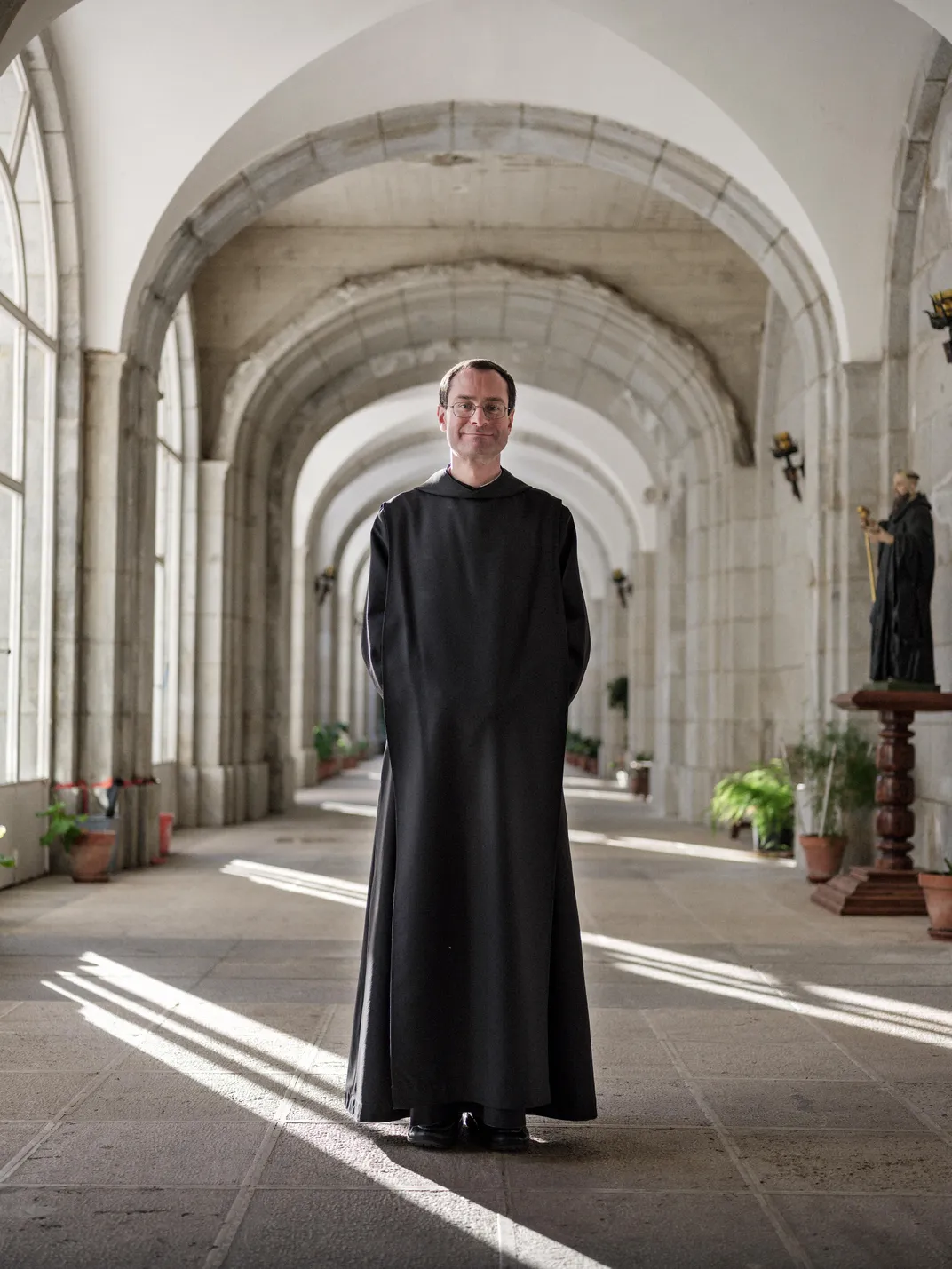
This past March, Cantera withdrew his petition against the exhumation of Manuel and Antonio Lapeña Altabás. He told me he was satisfied after receiving assurances that the search for the Lapeña brothers would cause no structural damage and that, if identified Nationalist remains would have to be disturbed, technicians would seek permission from the families first. But that was only part of the story.
A few days before his reversal, a high-ranking Spanish bishop, perhaps wary of a growing crisis between the Church and the state, stepped in to resolve the standoff. When I spoke to Cantera about his change of heart, he mentioned obliquely that his decision had been shaped in part by “the pressure received.”
Inspections of the crypts began on April 23. Puri was at the Valley’s front gate, although she wasn’t allowed inside. She wasn’t alone. Two other families, also working with Eduardo Ranz, had followed in her footsteps, and successfully petitioned the state to identify and, if possible, exhume their relatives: two Nationalist soldiers who died fighting for Franco, and whose remains were moved without their families’ consent.
The Valley is “nothing more than the egocentric symbol of a dictator, which uses the dead of both sides,” Héctor Gil, a grandson of one of the Nationalist soldiers, told reporters. Like Puri, the families hoped to give their relatives a proper burial, so they could finally lay the past to rest.
That morning, Puri and her husband stood beside the Gils and watched as the technicians were waved through the Valley's gate on their way to the crypts. Afterward, the two families went for a meal. They had never met before, and they wanted a chance to talk.
A Note to our Readers
Smithsonian magazine participates in affiliate link advertising programs. If you purchase an item through these links, we receive a commission.
